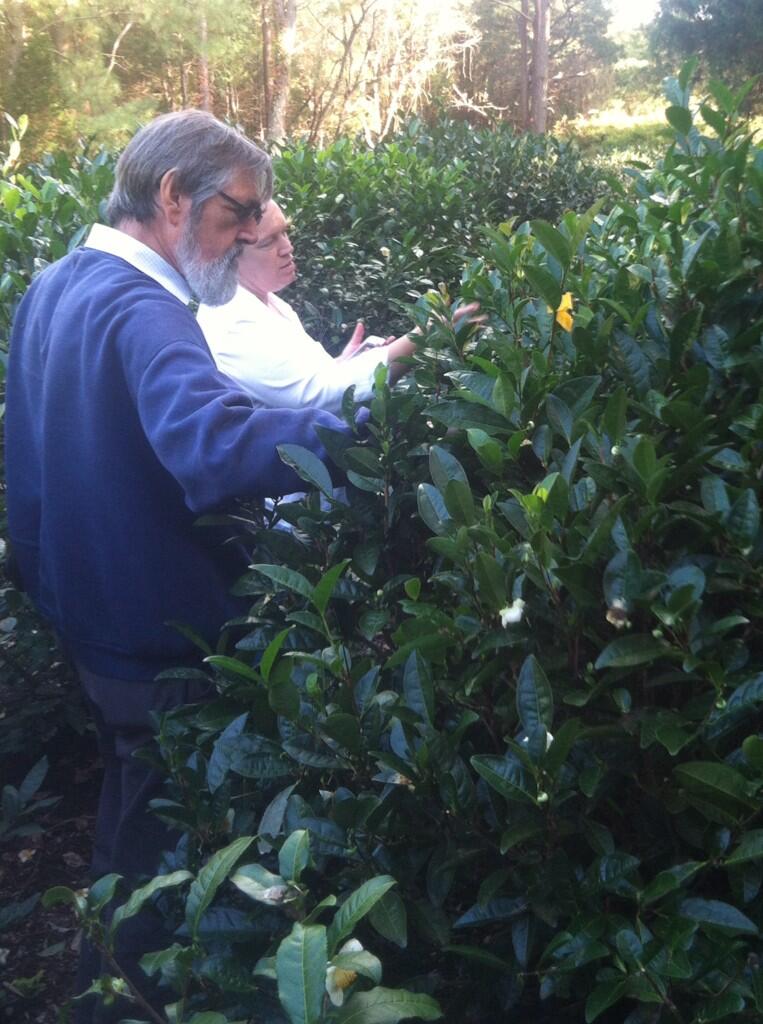 US Tea Planting Tips – Nigel Melican, Teacraft Ltd
US Tea Planting Tips – Nigel Melican, Teacraft Ltd
Remember these seven simple things to maximize your success with growing a tea bush in America:
1. Know your variety – variety determines cold hardiness. Tea comes as a China type (Camellia sinensis var. sinensis) – China types are quite cold tolerant. Or as Assamica type (Camellia sinensis var. assamica) – Assamicas do not like frost and are only suitable for wet areas of Plant Hardiness Zone 10b and above. Most tea plants you will find in the USA are hybrids between the two sub species so will withstand some winter frost – OK when grown unprotected for Zones 8b and above. For more severe winter conditions choose pure China types (or provide winter frost protection measures).
2. Soil – tea needs a free draining soil. It cannot stand “wet feet”. In a pot this means plenty of small grit and pine bark – a good open compost. In garden planting it means having well dug soil with at least 6 ft above the water table. Soil type is not so important but your soil (in pot or patch) must be acid. Tea thrives at pH 4.5 to 5.5. So your soil must start acid and stay acid – boosted by using acidifying fertilizers as sold for azaleas and camellias – with plenty of acid mulch. Pine needles are a good mulch, and keep down the weeds. If you are growing your bush to harvest its leaves then a fertilizer high in Nitrogen is recommended.
3. Water – your tea bush needs frequent watering, particularly as you have provided it with free draining soil. Bushes in pots dry out surprisingly quickly and may require a quart every day. Unless you are blessed with naturally soft city water with a pH below 5.5 (unlikely) to maintain your acid soil requires watering with rain water. This can be collected from your home or shed roof. Beware collecting water from roofs with alkaline tiles – and check its pH at intervals.
4. Temperature – tea is happy between 55⁰F and 90⁰F. Below 50⁰F at night and it will begin to go dormant. Above 95⁰F in summer and it will begin to show some stress. Shading and water misting can make summer afternoon heat more tolerable for your bush. In Zones 8 and below, with winter temperatures below 25⁰F you must give potted bushes some protection – place against a house wall out of the wind, or bring the dormant plant into a conservatory or greenhouse. When your local trees start their fall colors then it’s time to bring your potted teas in. Do not over water plants in winter – dry roots withstand cold better than wet. For soil planted bushes growing outside in low temperature zones you can cover them with horticultural fleece, or a layer of grass and pine needles thatched over the bushes. In really cold areas you might use a temporary hoop house (double layer plastic) and some insulation around the wood of the bushes. Hard frost is the killer - snow is not the enemy – it can insulate against frost damage.
5. Humidity – tea is a tropical plant and loves humidity. In really low humidity it will lose its leaves and go dormant, even when temperatures are suitable for growth. During dry periods it pays to mist your tea bush frequently with soft rain water, or spray using a hose. Keep the ground in your yard wetted down (but raise your pot above the ground an inch so it is not standing in a puddle). For tea bushes rooted in the soil you can use overhead sprinklers or spray with a hose. Remember though this is not irrigation – to maintain humidity frequent small amounts are better than an occasional drench.
6. Light – tea thrives on light provided you can keep it cool and humid – dappled shade is the best compromise – or horticultural shade on a larger scale. Start at 60% transmission and adjust up or down depending on summer heat. Leaf yield is proportional to light, provided all the other factors are within acceptable limits.
7. Pot size – as your tea bush grows you will need to repot, perhaps every two years, using the same acid free draining compost. Tea does not mind being pot bound and very healthy mature bushes can be grown in plastic pots of 15” diameter. When you have reached the maximum reasonable size pot your bush can maintained by repotting every five years be root pruned (take off about ½ to 1” of roots from the outside of the compacted ball using a sharp knife) and repot as normal. Tea bushes grown outside should be planted at about 36” apart (if you are seeking maximum leaf yield for processing) and kept pruned to maintain a productive plucking table.Gardening is all about adapting your growing conditions to best suit the needs of mainly exotic plants. When in doubt about keeping your tea plant happy remember that it evolved in a sub-tropical rain forest – so the closer you can maintain those conditions of warm humidity with frequent rainfall, dappled sunshine and a rich acidic free-draining organic soil– the happier your tea plant will be. It will reward you with vigorous growth, shiny dark green leaves, and a frequent harvest of tender bright green shoots. Enjoy!

